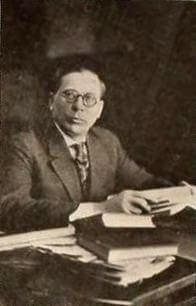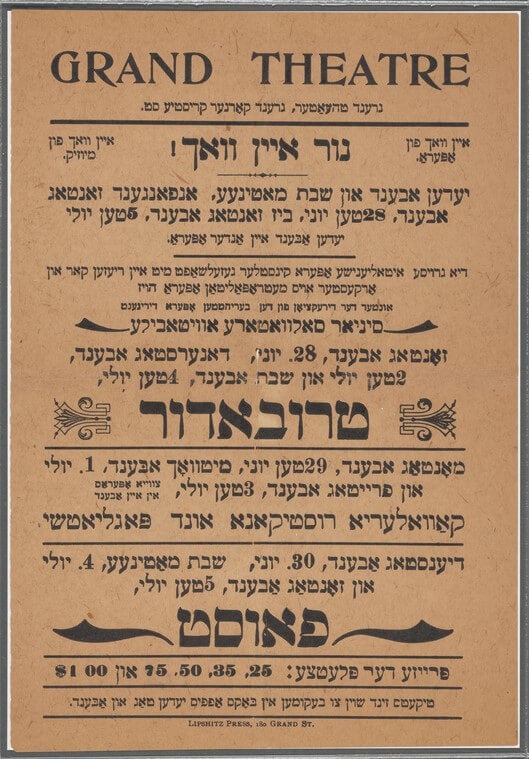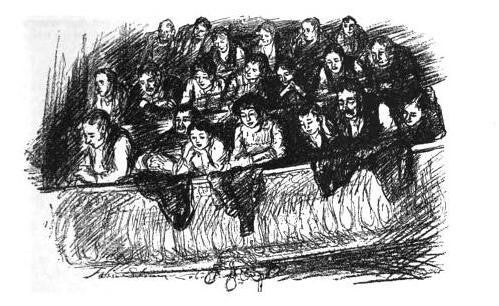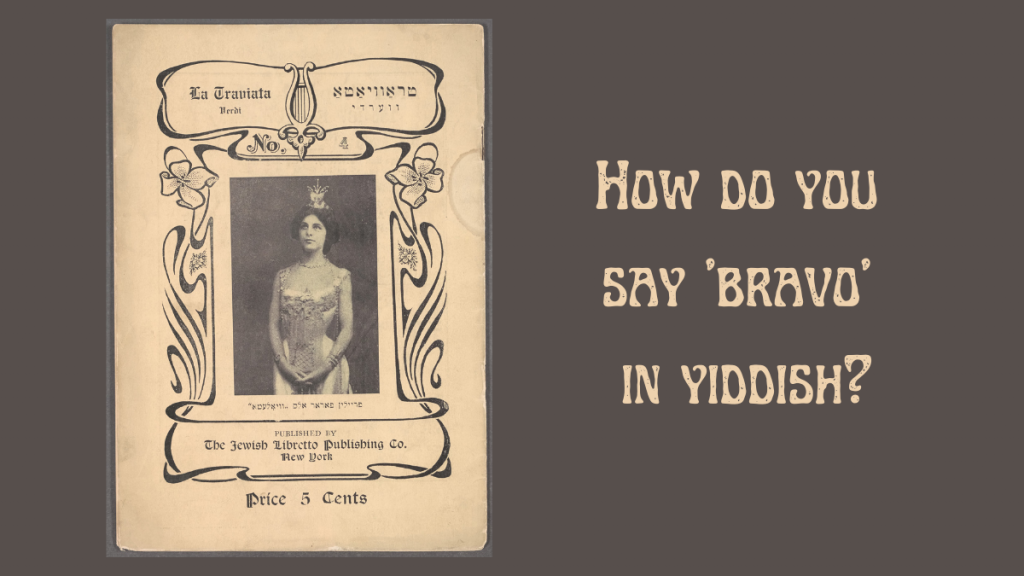by Daniela Smolov Levy
Yiddish-speaking immigrants in early twentieth-century America might seem an unlikely audience for grand operas in Italian. By this point, grand opera – large-scale nineteenth-century European sung dramas – in foreign languages had become firmly established as the domain of elites: the opera house was a place to see and be seen, where society ladies in glittering diamond tiaras and tuxedoed robber barons sat in gilded plush red velvet box seats, ogling one another with opera glasses and mostly ignoring the long, grandiose musical dramas enacted onstage in languages they did not know. Yiddish speakers didn’t exactly fit into this social group: they were predominantly poor or working class, often had little education, and were already provided with a dizzying array of cheap entertainment in the Yiddish theatre. So why would anybody try to promote grand opera among Yiddish speakers?
Many pieces to this puzzle have gotten lost in the shuffle of opera’s evolution over the last century. What is little known is that in the early 1900s there was a thriving world of grand opera in English translation at “popular prices” (meaning cheap tickets) all across the U.S. aimed at the middle and working classes [1]. What is even less known is that there was also demand among Italian immigrants for popular price opera in Italian, which was part of their national heritage and in their native language. [2] Less known still is the fact that some of these popular price companies also targeted Yiddish-speaking Jews out of the belief that this public genuinely wanted to attend the opera but simply couldn’t afford it.
Among the zealous opera democratizers of early twentieth-century America was the enterprising Ivan Abramson. A Russian-Jewish immigrant who had come to the United States in his teens, Abramson became involved with opera in New York in 1907. His eclectic background included experience in the restaurant business, journalism, theatre management, and real estate. Fulfilling his long-held dream to be an opera manager [3], he established Ivan Abramson’s Italian Lyric Company, which soon became known as Ivan Abramson’s Italian Grand Opera Company.

Abramson embarked on his venture out of the conviction that there was unfulfilled demand for opera among the Jews as well as Italians of New York’s Lower East Side, whom he believed would attend the opera if only it were cheaper. As he told a reporter for the New York Evening World in May 1907, “Italians and the Jews are all lovers of music, particularly of classical music. They have no use for the ragtime. They prefer opera to drama and a musical production that has merit gets their money much more easily than a good play. That is why I am trying to give it to them. … My whole idea is that the public wants grand opera that it can afford.” [4] This was not an unreasonable assumption. Since the late 1890s, Yiddish-speaking immigrants in New York had been a target audience for grand opera at popular prices. In 1903, for example, the conductor, music teacher, and impresario Salvatore Avitabile presented Italian opera aimed at Italians as well as Jews at the Grand Theatre on the Lower East Side, advertising the performances in the major Yiddish newspaper, the Forverts (Forward), as well as with Yiddish-language posters. During the craze surrounding the Metropolitan Opera’s controversial production of Parsifal the following year, Boris Thomashefsky staged a Yiddish adaptation of the work[5]. Although a season of Italian opera in Yiddish translation in the fall of 1904 at the Windsor Theatre was a flop, there was clearly ongoing interest among Jews in the genre during this period, judging by ads in newspapers for opera performances, newspaper and magazine articles written on opera topics, the printing of Yiddish opera librettos, and the publication of an entire book of Yiddish-language synopses of some of the most famous Italian, French, and German operas.

Abramson also built his company on the foundation of well-known interest among Italian immigrants for opera at popular prices. In addition to the performances of the Avitabile company, impresarios Gaetano D’Amato and Antonio Ferrara (of the famous Ferrara Café) had periodically offered short seasons of Italian opera in a range of New York venues beginning in 1904 that drew enthusiastic audiences. Ferrara had even originally established his café as a place for Italian opera lovers to congregate after performances. [6]

Yiddish-speaking Jewish immigrants and Italian immigrants in New York shared not only an interest in opera. Their lives in the early 1900s were also interwoven in other ways: they lived in the same neighborhood (the Lower East Side), often worked in similar types of jobs, were of a similar social status, and faced similar cultural challenges of being recent immigrants. They even shared theaters, such as the People’s Theatre on the Bowery and the Grand Theatre, which sometimes led to amusing incongruities, such as an advertising placard from a Yiddish theatre production to “Deal at Bernstein’s Clothing Emporium” turning up on the set of an opera performance of D’Amato and Ferrara’s company. [7]

Abramson thus capitalized on the cultural overlap between the two immigrant groups to promote his popular price opera company. Its quick success allowed it to move farther uptown within New York City, where it also attracted more affluent and native English-speaking audiences. The company even toured as far afield as the Midwest, where it targeted a broad public as well as Yiddish speakers. Although Abramson’s troupe lasted only until 1909 – cheap opera companies of the period were notoriously short-lived – it stands as a prime example of the way in which popular price opera impresarios sought to attract Yiddish-speaking audiences by finding points of cultural contact between Jewish immigrants and other social and ethnic groups in American society. Note: This post is the first of a five-part series based on the five lectures I will be giving at UCLA (via Zoom) between January and May 2022, “How Do You Say ‘Bravo’ in Yiddish?: Italian Opera for the Yiddish-Speaking Masses in Early 20th-Century America.” Sign up for the lectures.
[1] See, for example, the work of Katherine K. Preston, such as Opera on the Road: Traveling Opera Troupes in the United States, 1825-60 (Urbana and Chicago: University of Illinois Press, 1993) and Opera for the People: English-Language Opera and Women Managers in Late 19th-Century America (Oxford: Oxford University Press, 2017).
[2] Regarding Italian immigrants’ cultural connection to opera, see Larry Hamberlin, Tin Pan Opera: Operatic Novelty Songs in the Ragtime Era (Oxford: Oxford University Press, 2011).
[3] See Ivan Abramson, Mother of Truth: A Story of Romance and Retribution Based on the Events of My Own Life (New York: Graphic Literary Press, 1929), ix.
[4] Nixola Greeley-Smith, “Bowery Impresario Will Invade Broadway,” New York Evening World, May 30, 1907.
[5] See Daniela Smolov Levy, “Parsifal in Yiddish? Why Not?”, The Musical Quarterly 97, no. 2 (2014): 140-80. For more on Wagner aimed at Yiddish speakers, see Levy, “‘The Spirit of Struggle and Revolution’: Wagner for Yiddish Speakers in Early Twentieth-Century America” (“Im Geist des Kampfes und der Revolution”: Wagner für ein jiddischsprachiges Publikum im Amerika des frühen zwanzigsten Jahrhunderts), Wagnerspectrum, Schwerpunkt: Wagner – Weill – America, Heft 2/November 2020.
[6] According to the Café Ferrara website
[7] John S. Lopez, “Grand Opera on the Bowery,” Appleton’s Magazine, January 1907, 27.
